Shikun Liu
Graph-KV: Breaking Sequence via Injecting Structural Biases into Large Language Models
Jun 09, 2025Abstract:Modern large language models (LLMs) are inherently auto-regressive, requiring input to be serialized into flat sequences regardless of their structural dependencies. This serialization hinders the model's ability to leverage structural inductive biases, especially in tasks such as retrieval-augmented generation (RAG) and reasoning on data with native graph structures, where inter-segment dependencies are crucial. We introduce Graph-KV with the potential to overcome this limitation. Graph-KV leverages the KV-cache of text segments as condensed representations and governs their interaction through structural inductive biases. In this framework, 'target' segments selectively attend only to the KV-caches of their designated 'source' segments, rather than all preceding segments in a serialized sequence. This approach induces a graph-structured block mask, sparsifying attention and enabling a message-passing-like step within the LLM. Furthermore, strategically allocated positional encodings for source and target segments reduce positional bias and context window consumption. We evaluate Graph-KV across three scenarios: (1) seven RAG benchmarks spanning direct inference, multi-hop reasoning, and long-document understanding; (2) Arxiv-QA, a novel academic paper QA task with full-text scientific papers structured as citation ego-graphs; and (3) paper topic classification within a citation network. By effectively reducing positional bias and harnessing structural inductive biases, Graph-KV substantially outperforms baselines, including standard costly sequential encoding, across various settings. Code and the Graph-KV data are publicly available.
Structural Alignment Improves Graph Test-Time Adaptation
Feb 25, 2025Abstract:Graph-based learning has achieved remarkable success in domains ranging from recommendation to fraud detection and particle physics by effectively capturing underlying interaction patterns. However, it often struggles to generalize when distribution shifts occur, particularly those involving changes in network connectivity or interaction patterns. Existing approaches designed to mitigate such shifts typically require retraining with full access to source data, rendering them infeasible under strict computational or privacy constraints. To address this limitation, we propose a test-time structural alignment (TSA) algorithm for Graph Test-Time Adaptation (GTTA), a novel method that aligns graph structures during inference without revisiting the source domain. Built upon a theoretically grounded treatment of graph data distribution shifts, TSA integrates three key strategies: an uncertainty-aware neighborhood weighting that accommodates structure shifts, an adaptive balancing of self-node and neighborhood-aggregated representations driven by node representations' signal-to-noise ratio, and a decision boundary refinement that corrects remaining label and feature shifts. Extensive experiments on synthetic and real-world datasets demonstrate that TSA can consistently outperform both non-graph TTA methods and state-of-the-art GTTA baselines.
Model Generalization on Text Attribute Graphs: Principles with Large Language Models
Feb 17, 2025Abstract:Large language models (LLMs) have recently been introduced to graph learning, aiming to extend their zero-shot generalization success to tasks where labeled graph data is scarce. Among these applications, inference over text-attributed graphs (TAGs) presents unique challenges: existing methods struggle with LLMs' limited context length for processing large node neighborhoods and the misalignment between node embeddings and the LLM token space. To address these issues, we establish two key principles for ensuring generalization and derive the framework LLM-BP accordingly: (1) Unifying the attribute space with task-adaptive embeddings, where we leverage LLM-based encoders and task-aware prompting to enhance generalization of the text attribute embeddings; (2) Developing a generalizable graph information aggregation mechanism, for which we adopt belief propagation with LLM-estimated parameters that adapt across graphs. Evaluations on 11 real-world TAG benchmarks demonstrate that LLM-BP significantly outperforms existing approaches, achieving 8.10% improvement with task-conditional embeddings and an additional 1.71% gain from adaptive aggregation.
Learning Flow Fields in Attention for Controllable Person Image Generation
Dec 12, 2024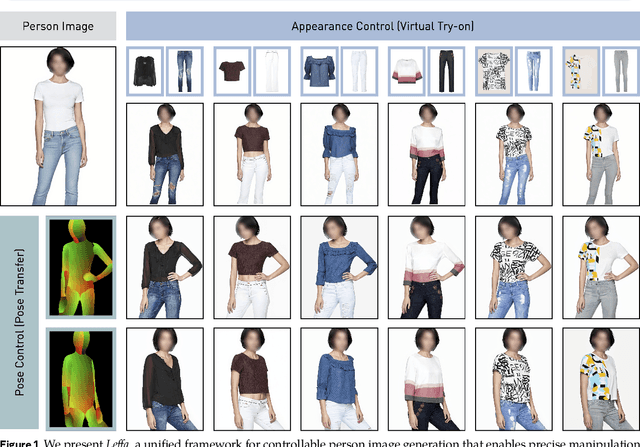
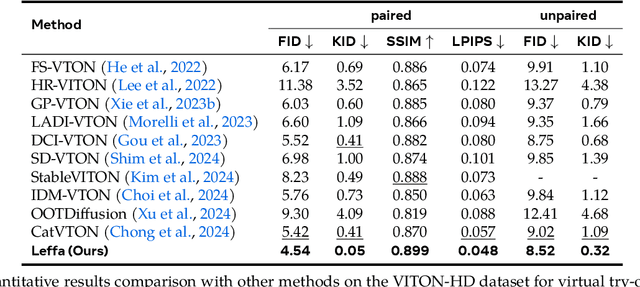
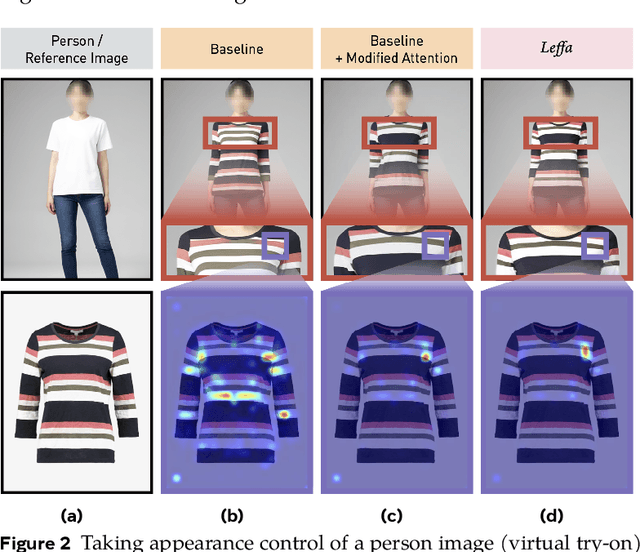

Abstract:Controllable person image generation aims to generate a person image conditioned on reference images, allowing precise control over the person's appearance or pose. However, prior methods often distort fine-grained textural details from the reference image, despite achieving high overall image quality. We attribute these distortions to inadequate attention to corresponding regions in the reference image. To address this, we thereby propose learning flow fields in attention (Leffa), which explicitly guides the target query to attend to the correct reference key in the attention layer during training. Specifically, it is realized via a regularization loss on top of the attention map within a diffusion-based baseline. Our extensive experiments show that Leffa achieves state-of-the-art performance in controlling appearance (virtual try-on) and pose (pose transfer), significantly reducing fine-grained detail distortion while maintaining high image quality. Additionally, we show that our loss is model-agnostic and can be used to improve the performance of other diffusion models.
MarDini: Masked Autoregressive Diffusion for Video Generation at Scale
Oct 26, 2024



Abstract:We introduce MarDini, a new family of video diffusion models that integrate the advantages of masked auto-regression (MAR) into a unified diffusion model (DM) framework. Here, MAR handles temporal planning, while DM focuses on spatial generation in an asymmetric network design: i) a MAR-based planning model containing most of the parameters generates planning signals for each masked frame using low-resolution input; ii) a lightweight generation model uses these signals to produce high-resolution frames via diffusion de-noising. MarDini's MAR enables video generation conditioned on any number of masked frames at any frame positions: a single model can handle video interpolation (e.g., masking middle frames), image-to-video generation (e.g., masking from the second frame onward), and video expansion (e.g., masking half the frames). The efficient design allocates most of the computational resources to the low-resolution planning model, making computationally expensive but important spatio-temporal attention feasible at scale. MarDini sets a new state-of-the-art for video interpolation; meanwhile, within few inference steps, it efficiently generates videos on par with those of much more expensive advanced image-to-video models.
Pairwise Alignment Improves Graph Domain Adaptation
Mar 02, 2024



Abstract:Graph-based methods, pivotal for label inference over interconnected objects in many real-world applications, often encounter generalization challenges, if the graph used for model training differs significantly from the graph used for testing. This work delves into Graph Domain Adaptation (GDA) to address the unique complexities of distribution shifts over graph data, where interconnected data points experience shifts in features, labels, and in particular, connecting patterns. We propose a novel, theoretically principled method, Pairwise Alignment (Pair-Align) to counter graph structure shift by mitigating conditional structure shift (CSS) and label shift (LS). Pair-Align uses edge weights to recalibrate the influence among neighboring nodes to handle CSS and adjusts the classification loss with label weights to handle LS. Our method demonstrates superior performance in real-world applications, including node classification with region shift in social networks, and the pileup mitigation task in particle colliding experiments. For the first application, we also curate the largest dataset by far for GDA studies. Our method shows strong performance in synthetic and other existing benchmark datasets.
EscherNet: A Generative Model for Scalable View Synthesis
Feb 06, 2024Abstract:We introduce EscherNet, a multi-view conditioned diffusion model for view synthesis. EscherNet learns implicit and generative 3D representations coupled with a specialised camera positional encoding, allowing precise and continuous relative control of the camera transformation between an arbitrary number of reference and target views. EscherNet offers exceptional generality, flexibility, and scalability in view synthesis -- it can generate more than 100 consistent target views simultaneously on a single consumer-grade GPU, despite being trained with a fixed number of 3 reference views to 3 target views. As a result, EscherNet not only addresses zero-shot novel view synthesis, but also naturally unifies single- and multi-image 3D reconstruction, combining these diverse tasks into a single, cohesive framework. Our extensive experiments demonstrate that EscherNet achieves state-of-the-art performance in multiple benchmarks, even when compared to methods specifically tailored for each individual problem. This remarkable versatility opens up new directions for designing scalable neural architectures for 3D vision. Project page: \url{https://kxhit.github.io/EscherNet}.
GDL-DS: A Benchmark for Geometric Deep Learning under Distribution Shifts
Oct 12, 2023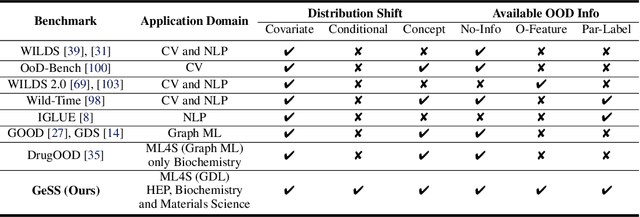
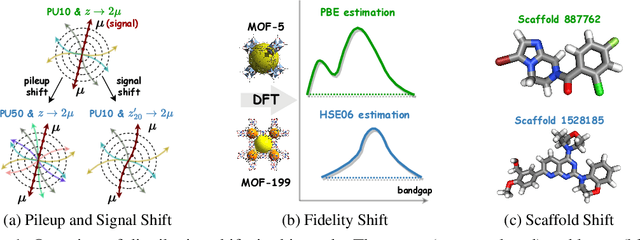

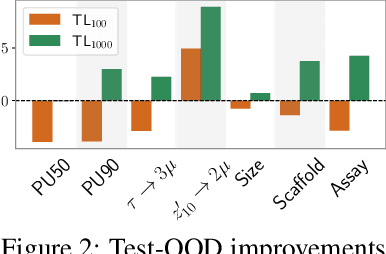
Abstract:Geometric deep learning (GDL) has gained significant attention in various scientific fields, chiefly for its proficiency in modeling data with intricate geometric structures. Yet, very few works have delved into its capability of tackling the distribution shift problem, a prevalent challenge in many relevant applications. To bridge this gap, we propose GDL-DS, a comprehensive benchmark designed for evaluating the performance of GDL models in scenarios with distribution shifts. Our evaluation datasets cover diverse scientific domains from particle physics and materials science to biochemistry, and encapsulate a broad spectrum of distribution shifts including conditional, covariate, and concept shifts. Furthermore, we study three levels of information access from the out-of-distribution (OOD) testing data, including no OOD information, only OOD features without labels, and OOD features with a few labels. Overall, our benchmark results in 30 different experiment settings, and evaluates 3 GDL backbones and 11 learning algorithms in each setting. A thorough analysis of the evaluation results is provided, poised to illuminate insights for DGL researchers and domain practitioners who are to use DGL in their applications.
Structural Re-weighting Improves Graph Domain Adaptation
Jun 05, 2023Abstract:In many real-world applications, graph-structured data used for training and testing have differences in distribution, such as in high energy physics (HEP) where simulation data used for training may not match real experiments. Graph domain adaptation (GDA) is a method used to address these differences. However, current GDA primarily works by aligning the distributions of node representations output by a single graph neural network encoder shared across the training and testing domains, which may often yield sub-optimal solutions. This work examines different impacts of distribution shifts caused by either graph structure or node attributes and identifies a new type of shift, named conditional structure shift (CSS), which current GDA approaches are provably sub-optimal to deal with. A novel approach, called structural reweighting (StruRW), is proposed to address this issue and is tested on synthetic graphs, four benchmark datasets, and a new application in HEP. StruRW has shown significant performance improvement over the baselines in the settings with large graph structure shifts, and reasonable performance improvement when node attribute shift dominates.
Prismer: A Vision-Language Model with An Ensemble of Experts
Mar 12, 2023Abstract:Recent vision-language models have shown impressive multi-modal generation capabilities. However, typically they require training huge models on massive datasets. As a more scalable alternative, we introduce Prismer, a data- and parameter-efficient vision-language model that leverages an ensemble of domain experts. Prismer only requires training of a small number of components, with the majority of network weights inherited from readily-available, pre-trained domain experts, and kept frozen during training. By leveraging experts from a wide range of domains, we show that Prismer can efficiently pool this expert knowledge and adapt it to various vision-language reasoning tasks. In our experiments, we show that Prismer achieves fine-tuned and few-shot learning performance which is competitive with current state-of-the-art models, whilst requiring up to two orders of magnitude less training data. Code is available at https://github.com/NVlabs/prismer.
 Add to Chrome
Add to Chrome Add to Firefox
Add to Firefox Add to Edge
Add to Edge